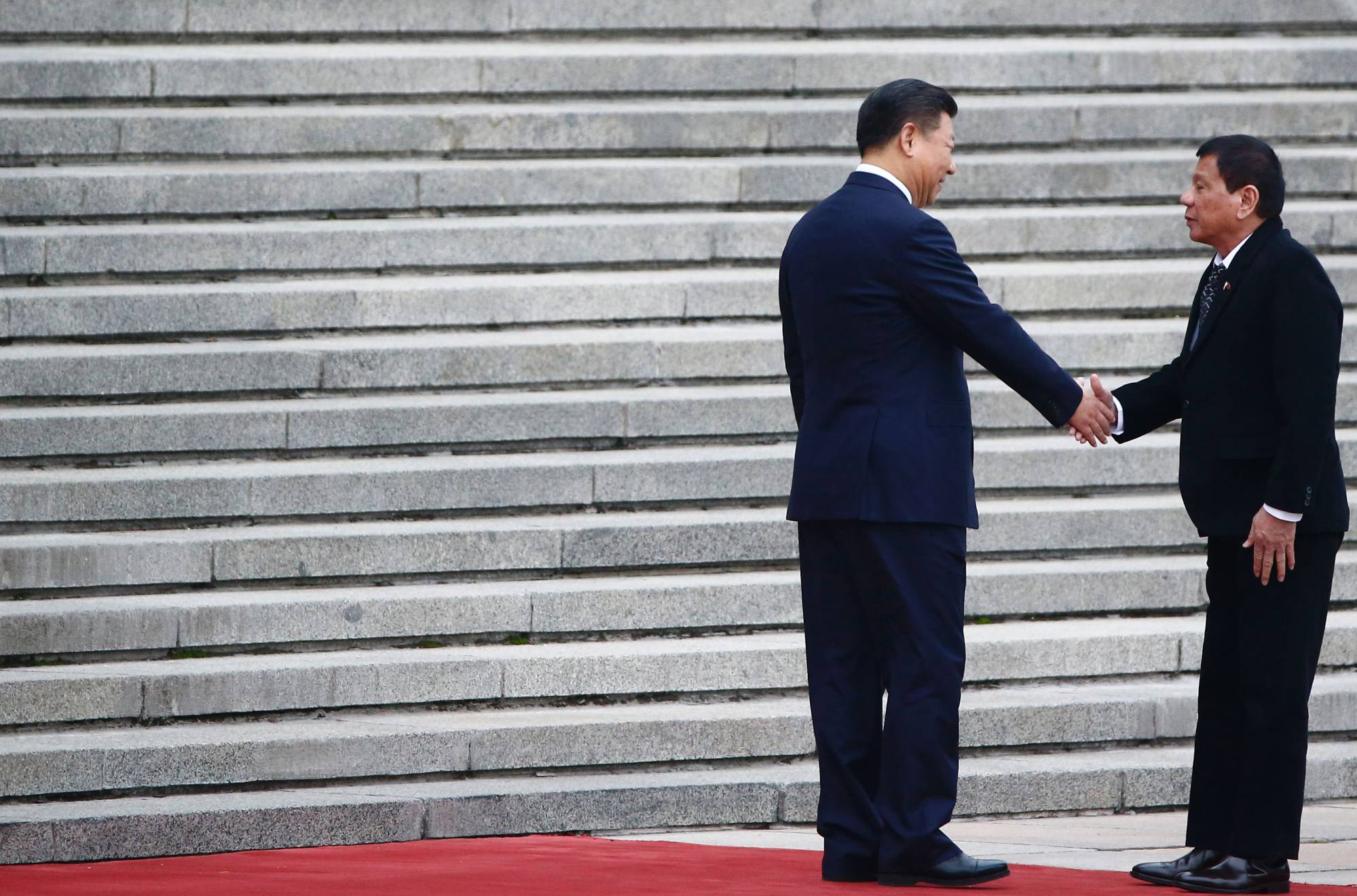
Manila to stay transparent over South China Sea row against Beijing’s ‘bullying’
Manila to stay transparent over South China Sea row against Beijing’s ‘bullying’
Defence analysts say Manila and Washington are now united in their opposition to Beijing’s “maritime expansionism” in the South China Sea, which the latter claims almost in its entirety.
“What annoys [China] is that we have a defence treaty with the US,” Logico said.
Touching base
The two countries, bound by a 1951 mutual defence treaty, agreed last year to expand the number of sites covered by their Enhanced Defence Cooperation Agreement (EDCA) to nine from the initial four – to respond to “shared challenges”, as a Pentagon spokesman euphemistically put it at the time.
The EDCA sites evoke memories of two giant Cold War-era US bases, the largest outside America at the time.

For more than 40 years, Clark Air Base and Subic Naval Base – alongside 23 other installations – were for the exclusive use of the Americans, with the Philippines having little or no say in the matter. Packed with US ships, aircraft and troops, they also stored nuclear weapons.
Successive administrations in Manila defined their nationalism by either supporting or opposing the bases, though in private all supported them for “protecting” the Philippines from communist aggression.
The fall of the Soviet Union in 1991, which coincided with a volcanic eruption that covered the bases in ash and the Philippines’ refusal to renew leases on both following a dispute over rent, led to the US abandoning them a year later.
Circumstances have changed in the decades since. In December, the Philippines’ House of Representatives passed a resolution condemning Chinese aggression in the West Philippine Sea, as Manila calls the parts of the South China Sea within its exclusive economic zone, and calling on the government to continue asserting its rights.
Philippine military races for sea change amid China’s rising maritime threat
Philippine military races for sea change amid China’s rising maritime threat
But the country’s defence budget remains low compared to its neighbours. Last year, Manila spent just over US$7 billion on its military, less than Malaysia’s US$8.9 billion, Singapore’s US$17 billion, Indonesia’s US$18 billion – and far behind the US$377 billion China reportedly spent.
“We are going for interoperability,” Colonel Logico said. “We are trying to see, if we go to war, are our … soldiers familiar with the capabilities of our treaty allies?
“To work together we need to have the same terminologies, appreciation of the operational environment,” he added.
‘The ants that get trampled on’
Not everyone agrees with drawing closer to the US, however, and they warn about the Philippines turning into a “proxy” for American interests. The president’s own sister Imee, a senator, told ANC Digital earlier this month that “China will always be our neighbour, we have no fight with them, let’s not get dragged into a fight that’s not our own.”
Anna Rosario Malindog-Uy, director of the pro-China Asian Century Philippines Strategic Studies Institute, wrote in the Manila Times on February 10 that “agreements such as the EDCA, the VFA and the Mutual Defence Treaty have not only cemented the US military presence and influence in the Philippines but also, most importantly, exemplified the Philippines’ dependence on the US in the military and defence sector.”
Teresita Ang See, former president of the Philippine Association for Chinese Studies and currently part of its advisory council, told This Week in Asia: “Filipinos in general condemn China’s action. But many also understand that China’s assertiveness is in response to US, Japanese and Australian provocations and increasing military presence in the Philippines.”
She warned that “we are fighting a proxy war between the US and China and in the end we will be the ants that get trampled upon”.
We are fighting a proxy war between the US and China and in the end we will be the ants that get trampled upon
Chester Cabalza, founder and president of the International Development and Security Cooperation think tank, disagreed with this definition, noting that “a proxy war [only] commences when there is a military conflict”.
Another defence analyst, who asked not to be named, stressed that the Philippines did have “legitimate interests” in regards to China that shared “some similarities” with those of the US.
“It is the duty of any nation to protect its territorial and maritime interests. To argue that we are simply being used as pawns is Chinese propaganda,” he said.
For Colonel Logico, stepping up military exercises with the US is all about “deterring China”. “We are sending the message, you know, you want to try your luck with us, we are ready for you,” he told This Week in Asia.
“I belong to the armed forces, I’m in uniform. I will always see things from the realist perspective,” Logico said. “I’m aware of the Thucydides trap – the idea that a rising power will eventually collide with an existing power. And one way to avoid this is through deterrence … discouraging the other party from making any overt acts that will take aggression a step further.”
The idea that China could displace the US as the Philippines’ main ally had crossed his mind during the Duterte administration, he revealed.
“There was a time when I really thought it would happen. But China committed one strategic error. They did not deliver what they promised,” Logico said.

Duterte’s was “the most China-friendly administration the Philippines has seen”, said the Filipino defence analyst who declined to be identified. But during his six years in power “China actually delivered quite little”.
The shift away from Duterte’s pro-China stance has met with little resistance as most Filipinos are traditionally pro-American. Millions of Filipino-Americans live in the United States and it remains a popular goal to emigrate to the country.
In fact, a 2014 survey by the Pew Research Centre’s Global Attitudes Project found that 85 per cent of Filipinos had favourable views of the US – compared to just 84 per cent of Americans.
Philippines’ US ties risk more than links with China, expert warns
Philippines’ US ties risk more than links with China, expert warns
A more recent poll conducted by survey firm Pulse Asia, whose findings were published last month, showed that eight in 10 Filipinos wanted their country to work with the US – as well as Australia, Japan, Canada and Britain – to resolve the South China Sea issue.
Only one in 10 said they would prefer to work with China. In the same survey, 67 per cent of respondents said they believed in the need to strengthen the Philippines’ external defence capability, especially its navy, air force and coastguard.
In terms of its organisation, training, equipment and traditions, the Philippines’ military has long imitated that of the US.

He credited this to the fact that “almost all [Filipino] officers will go to America to study about militaristic things. That’s why they have this rapport and I cannot deny that”.
By contrast, the first time any Filipino officer studied in Beijing was during the Duterte administration’s pivot to China when a handful were sent there as part of an exchange programme, according to military sources who asked not to be named.
Meanwhile, even religious officials have, in effect, given their blessing to the current government’s efforts to seek allies against China. In a “joint pastoral exhortation” dated February 8, six bishops from the Philippines’ Catholic Church stated: “It is no secret that the aggressive incursions of the Chinese into our maritime zones” had resulted in the destruction of maritime resources and “wrought havoc on the lives of our fisherfolk”.
The bishops, coming from areas with fishing communities, said that in the absence of effective diplomacy, “then it is permissible – morally necessary even – to have recourse to the friendship of allies who can help us defend what is ours”.
‘A third world war is possible’
Manila’s defence department fired back a testy reply. “China has no business warning the Philippines what it does within its territory,” it said, adding: “China’s pronouncements and acts are the main reasons for its low credibility with the American people.” Philippine officials have said that this year’s Balikatan exercise with the US, scheduled for April, might include drills on and around Mavulis, an island in the Batanes archipelago just 150km southeast of Taiwan where the military is building a base.

In a recent forum, Asian Century Philippines Strategic Studies Institute’s Malindog-Uy said: “The South China Sea issue should not define the entire relationship between China and the Philippines because that is too small … if only people and the government of both countries would see it that way, then probably a military confrontation in the South China Sea will never happen.”
“However, if this template is not managed properly, a third country like the United States will come into the picture and push the Philippines to … provoke China … a third world war is possible,” she added.
Asked if the Philippines could go it alone without its main ally, Logico said: “We are trying to get there. Once we transition away from internal security, then we can focus all our capability for external defence. If you want things done fast, you do it alone.”
Could Duterte’s Mindanao bid ‘distract’ Philippines from South China Sea row?
Could Duterte’s Mindanao bid ‘distract’ Philippines from South China Sea row?
“But if you want things done faster, you do it with friends. I see no strong reason why you shouldn’t do it with your treaty ally,” he added. “Is it inevitable that we need allies? Yes, we need them. We are not yet on the right footing. Besides, the US also needs us.”
“If you are expected to die for your country, if you were in my position, you would also use everything to your advantage. Would you want to do this alone or with a strategic ally? It would be stupid not to use an ally.”
EMEA Tribune is not involved in this news article, it is taken from our partners and or from the News Agencies. Copyright and Credit go to the News Agencies, email [email protected] Follow our WhatsApp verified Channel









